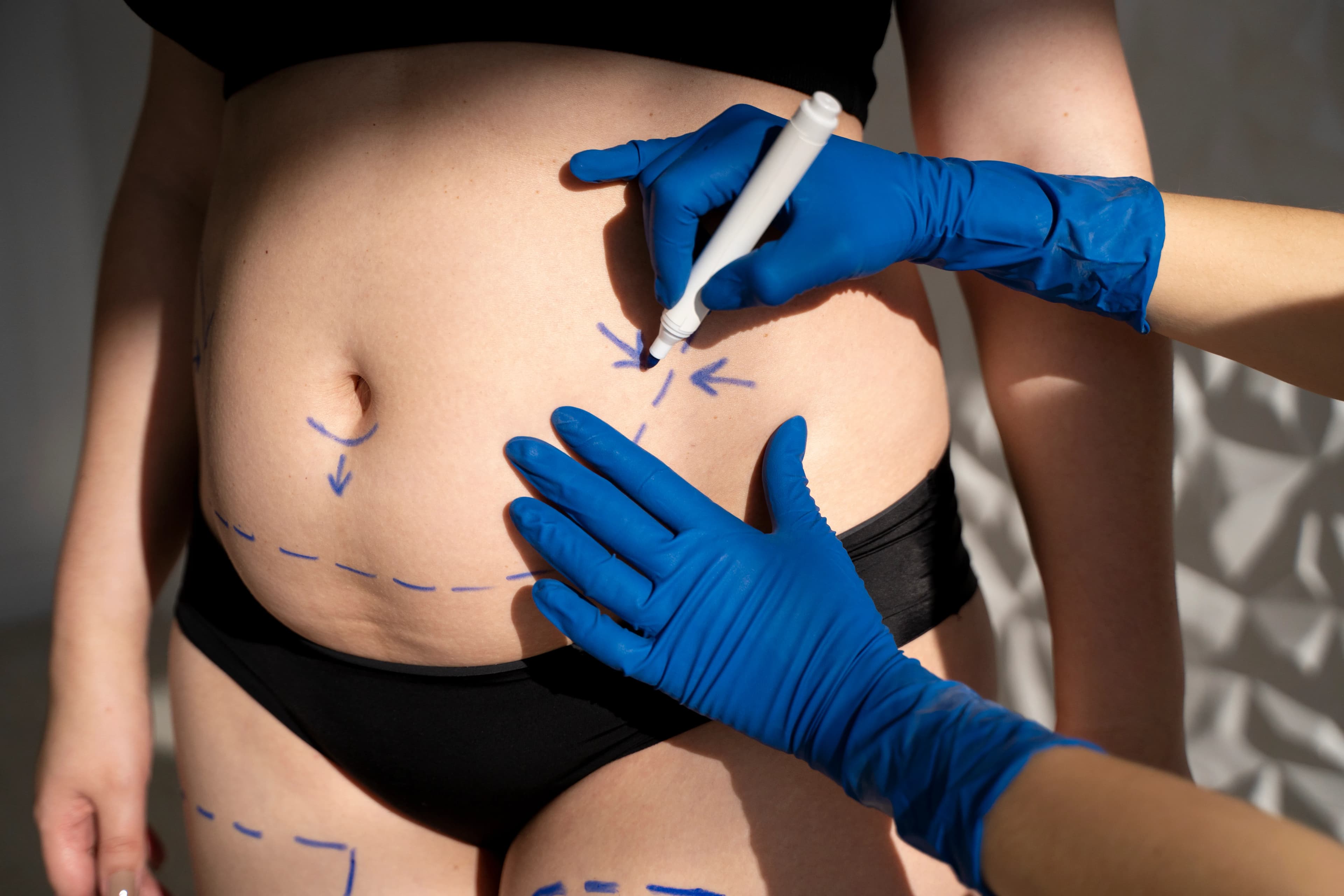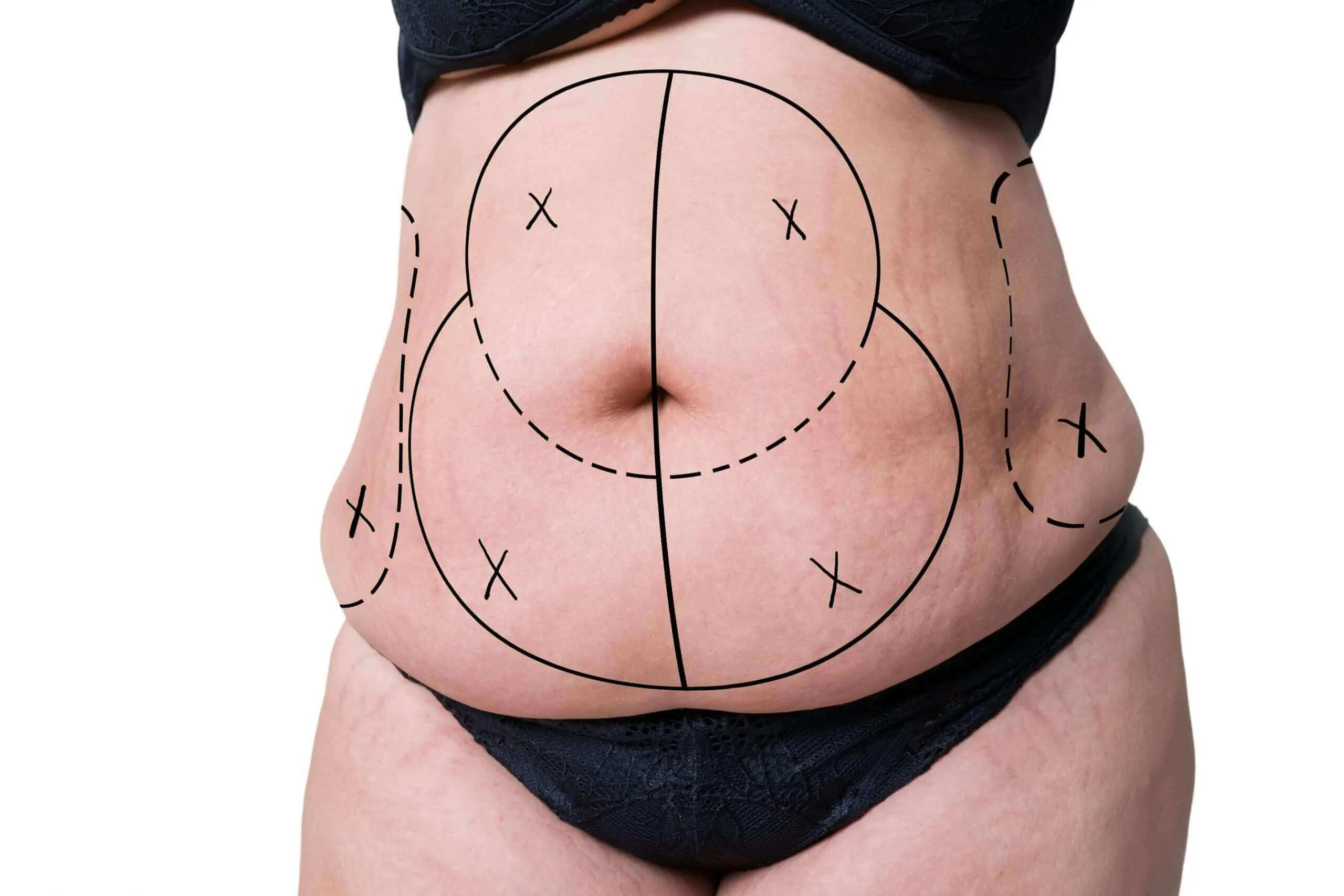Overview
During a tummy tuck, excess skin and fat are removed from the abdomen. Usually, the connective tissue in the abdomen is tightened as well via sutures. Then, the remaining skin is re-positioned to create a more toned look.

Abdominoplasty (Tummy Tuck) is a cosmetic surgical procedure to improve the shape and appearance of the abdomen by removing excess skin and fat & creates a more toned look.
During a tummy tuck, excess skin and fat are removed from the abdomen. Usually, the connective tissue in the abdomen is tightened as well via sutures. Then, the remaining skin is re-positioned to create a more toned look.
If you have excess fat or skin around your belly button or a weak lower abdominal wall you may choose a tummy tuck. Some reasons for excess fat, poor elasticity of the skin, and weakened connective tissue in your abdomen include:
Significant changes in weight
Pregnancy
Abdominal surgery, such as a C-section
Aging
Your natural body type
A tummy tuck procedure will remove loose, excess skin and fat, and tighten weak fascia. Any stretch marks or excess skin in the lower abdomen (below the belly button) may also be removed during a tummy tuck. In addition to removing excess fat from the abdomen, a tummy tuck also removes excess skin. Pregnancy or significant shifts in your weight can stretch out the skin that surrounds your stomach. A tummy tuck can be used to restore the look of a flat and contoured midsection. But if you've had stretch marks outside of this area, for example, a C-section, your surgeon may be able to incorporate your existing C-section scar into your tummy tuck scar. You may want to reconsider a tummy tuck if:
Your body mass index is over 30
You’re considering getting pregnant in the future
You’re actively trying to lose weight
You have a chronic heart condition

Abdominoplasty, widely known as a tummy tuck, is a surgical procedure designed to reshape and firm the abdomen. It involves the removal of excess skin and fat from the middle and lower abdomen to tighten the muscle and fascia of the abdominal wall. This procedure is particularly beneficial for individuals who have experienced significant changes in their body due to weight fluctuations, pregnancy, or aging, which can result in sagging skin and weakened muscles that no longer respond to diet and exercise.
The cost of abdominoplasty may vary based on the patient's specific surgical needs, surgeons' fees, way of treatment, and hospital fees.
Based on what result you expect from your surgery, the plan may vary. In most cases, patients return to work within 7-10 days after a tummy tuck. But to return to exercise you may need to wait 4-6 weeks. By 3-6 months post-op, patients can enjoy their permanent results.
A tummy tuck is considered a more intensive procedure than liposuction. A liposuction procedure will only remove excess fat, while a tummy tuck reconstructs the muscles of the abdomen as well as removing excess skin.
You can expect mild to moderate pain after a tummy tuck. If your pain is severe or persistent, you should tell your healthcare provider.
An abdominoplasty (tummy tuck) is a major surgery during which excess skin and fat is removed from the abdomen. This surgery can be appropriate for women who’ve had many pregnancies or anyone who has lost a lot of weight.
Abdominoplasty is a transformative procedure that can provide individuals with a flatter, more toned abdominal area that is more proportionate with their body type and weight. It is a comprehensive solution for addressing excess skin and weakened muscles that cannot be corrected through non-surgical means. As with any surgical procedure, it is essential to consult with a qualified plastic surgeon to discuss the potential risks and benefits, as well as to set realistic expectations for the outcome.
The results of abdominoplasty can be long-lasting, provided that patients maintain a stable weight and follow a healthy lifestyle. It's important to have realistic expectations and understand that while a tummy tuck can enhance one's appearance and self-confidence, it does produce a permanent scar that may take time to fade.
The difference between a mini tummy tuck and a full tummy tuck can be confusing. While most people think the term “mini” simply implies a shorter incision, the actual medical definition of a mini tummy tuck refers to removing some skin in the lower abdomen without incising around the belly button or tightening the muscles above the belly button.
Fluid accumulation beneath the skin (seroma)
Poor wound healing
Unexpected scarring
Tissue damage
Changes in skin sensation
Recovery time after an abdominoplasty surgery takes at least 2-3 weeks, and patients need to avoid heavy lifting, to reduce scarring, bruising, and swelling.
Equipped hospitals and advanced specialized centers with experienced doctors and specialists are available in all medical treatment areas in Iran. Also, good hotels and entertainment centers have made Iran an appropriate choice for patients who suffer from obesity and need abdominoplasty to lose weight.

Abdominoplasty, also known as a tummy tuck, is a cosmetic surgery procedure that has gained popularity worldwide, including in Iran. The cost of abdominoplasty in Iran is considerably lower compared to many Western countries, making it an attractive destination for medical tourism. The affordability of the procedure, combined with the expertise of Iranian surgeons, contributes to the country's reputation as a hub for cosmetic surgery.
The cost of a tummy tuck in Iran varies depending on several factors, including the complexity of the surgery, the surgeon's experience, and the facility where the surgery is performed. On average, the price for a tummy tuck in Iran is around 1,800-5,500 USD. This cost often includes the surgery itself, post-operative care, and sometimes additional services such as accommodation and transportation.
In Iran, abdominoplasty is performed by highly skilled surgeons who are experienced in delivering quality results. The lower cost does not compromise the quality of care, as Iranian medical centers are equipped with modern facilities and follow international standards. The types of tummy tuck procedures available in Iran include the mini tummy tuck, complete tummy tuck, and extended tummy tuck, with prices starting as low as $1,000 for a mini tummy tuck and going up to $4,000 for more extensive procedures.
Patients considering abdominoplasty in Iran can expect a comprehensive service package. The process typically involves pre-surgery consultations, the surgery itself, and a follow-up period during which the patient's recovery is closely monitored. The total stay in Iran for the procedure is usually around 7 to 10 days, allowing for adequate post-operative care and recovery time before traveling back home. The cost-effectiveness of abdominoplasty in Iran is coupled with the opportunity for patients to experience the rich culture and hospitality of the country. Many medical tourists take advantage of their visit to explore Iran's historical sites and enjoy its cuisine.
The abdominoplasty procedure begins with the administration of anesthesia to ensure the patient's comfort during the surgery. The choices include intravenous sedation and general anesthesia, with the specific method being recommended by the surgeon based on the patient's individual needs.
Once the patient is under anesthesia, the surgeon makes a horizontally-oriented incision in the area between the pubic hairline and belly button. The shape and length of the incision are determined by the amount of excess skin that needs to be removed. After making the incision, the surgeon lifts the abdominal skin to access the underlying weakened abdominal muscles.
These muscles are often stretched out or separated, a condition known as diastasis recti, which is common after pregnancy or significant weight changes. The surgeon repairs these muscles by suturing them together, thereby creating a firmer abdominal wall and a more defined waistline.
Following the muscle repair, the surgeon stretches the skin flap down, trims away the excess skin, and creates a new opening for the belly button. The belly button is then brought out through this new opening and sutured into position, ensuring it maintains a natural appearance in its new location.
The final step involves closing the incisions. This is done using sutures, skin adhesives, tapes, or clips, depending on the surgeon's preference and the specifics of the procedure. In some cases, temporary drains may be inserted to prevent fluid buildup and aid in the healing process.
After the surgery, patients can expect to see a flatter, firmer abdominal contour that is more proportionate with their body type and weight. The results of a tummy tuck are typically long-lasting, especially when patients maintain a stable weight and adhere to a healthy lifestyle.
Consultation and Research: Start by scheduling consultations with board-certified plastic surgeons who have extensive experience in abdominoplasty. Research their qualifications, review before-and-after photos of their work, and ensure you feel comfortable with their approach.
Medical Evaluation: Undergo a comprehensive medical evaluation, including lab testing, to assess your suitability for the surgery. This will help identify any potential health issues that could complicate the procedure or recovery.
Stable Weight: Achieve and maintain a stable weight for at least several months before the surgery. Significant weight fluctuations can affect the results of the tummy tuck, so it's best to be at a stable weight that you feel you can maintain after the procedure.
Quit Smoking: Smoking can decrease blood flow in the skin and slow down the healing process. If you smoke, you'll need to quit well in advance of the surgery to reduce the risk of complications and promote better healing.
Medication Review: Discuss your current medications with your surgeon. You may need to avoid taking certain medications, such as aspirin, anti-inflammatory drugs, and herbal supplements, as they can increase bleeding during and after the procedure.
Healthy Lifestyle: Adopt a healthy lifestyle that includes a balanced diet and regular exercise. Good nutrition and fitness can help strengthen your body, improve your immune response, and aid in a quicker recovery.
Alcohol Intake: Limit your alcohol consumption, as alcohol can affect your body's ability to heal and fight off infection. It's best to minimize alcohol intake in the weeks leading up to the surgery.
Stress Management: Implement stress management techniques such as meditation, yoga, or deep breathing exercises. Chronic stress can affect your health and immune response, so finding ways to manage stress can be beneficial.
Pre-Surgery Preparations: As the surgery date approaches, make arrangements for leave from work, childcare, pet care, and transportation. Set up a support system to help with your care during the post-surgery recovery phase.
By following these steps, you can prepare your body and mind for the abdominoplasty procedure and set the stage for a smooth recovery and optimal results.
Pain Management: You will likely be prescribed pain medication to manage post-operative discomfort. If the pain is not severe, you may opt for over-the-counter options like Tylenol, but be careful not to exceed the recommended dosage.
Nausea Control: Nausea is a common side effect after general anesthesia and taking strong medications. If you experience nausea, it's advised to take the prescribed anti-nausea medication.
Preventing Constipation: Narcotic pain relievers can cause constipation. To mitigate this, consider taking over-the-counter laxatives and do not wait until you are constipated to start taking them.
Nutrition and Hydration: Maintain a light, low-fat diet initially and gradually return to your regular diet if you're not feeling nauseous. Stay hydrated by drinking 8-10 glasses of water a day, and avoid alcohol while taking pain medications.
Activity and Exercise: Movement is important to prevent blood clots and aid in recovery. Start walking as soon as possible after surgery, but avoid strenuous exercise for about 1 week. Gradually build back up to your previous exercise levels, keeping in mind that swelling may temporarily worsen with exercise.
Compression Garment: Expect to wear a compression garment for 4-6 weeks post-surgery. It should fit snugly but not so tight as to cause difficulty breathing or develop wounds. The garment helps minimize swelling and aids in body contouring.
Incision Care: Keep your incisions clean and inspect them daily for signs of infection. Avoid sun exposure on the scars for at least 12 months and use a strong sunblock (SPF 30 or greater) if unavoidable. Do not soak in tubs while drains are in place and for 6-8 weeks following surgery.
Sleeping Position: Sleep with your head slightly elevated and pillows under your knees to decrease tension on your incision.
Emotional and Physical Expectations: It's normal to experience temporary soreness, bruising, swelling, and tightness, as well as discomfort in the incision area. Most discomfort will subside after the first few days, but you may feel tired for several weeks or months.
Follow-Up Care: Follow your surgeon's instructions for follow-up appointments and any additional care required. It's important to attend all scheduled visits to ensure proper healing and address any concerns promptly.
Abdominoplasty is a surgical procedure that offers both aesthetic and potential health benefits, but also comes with its own set of risks.
Improved Body Contour: The primary benefit of abdominoplasty is the improved body contour that comes from the removal of excess skin and fat and the tightening of the abdominal muscles. This can result in a flatter, more toned abdomen.
Enhanced Self-Image: Many patients experience a boost in self-confidence and body image following the procedure, as it can significantly change one's appearance and enhance the fit of clothes.
Potential Health Benefits: While not a weight-loss surgery, abdominoplasty may offer health benefits such as reduced back pain by restoring weakened or separated abdominal muscles, which can strengthen the core and provide more back support.
Surgical Risks: Like any major surgery, abdominoplasty carries risks such as bleeding, infection, and an adverse reaction to anesthesia.
Seroma: Fluid accumulation beneath the skin is a common complication, which may require drainage to resolve.
Poor Wound Healing: Some areas along the incision line may heal poorly or begin to separate, potentially leading to scarring or the need for additional surgeries.
Tissue Damage: Fatty tissue deep within the skin in the abdominal area might get damaged or die, especially in smokers, which can affect the overall outcome.
Changes in Skin Sensation: The repositioning of abdominal tissues can affect nerves, leading to changes in skin sensation or numbness.
Scarring: The procedure leaves a permanent scar, typically along the bikini line. The length and visibility of the scar vary from person to person.
After undergoing abdominoplasty, patients enter a recovery phase that is crucial for ensuring the best possible outcome. The first few days post-surgery are typically the most challenging, with patients experiencing discomfort and swelling. It is imperative to follow the surgeon's instructions meticulously during this period. Pain management is usually achieved through prescribed medications, and activities are limited to promote healing. Patients are advised to avoid strenuous exercise, heavy lifting, and any activity that may strain the abdominal area.
A critical aspect of aftercare is the management of surgical drains, which are often placed to prevent fluid accumulation at the site of the surgery. These drains are usually removed within one to two weeks post-operation, depending on the surgeon's assessment and the amount of fluid being collected. Proper care of the incision site is also essential to prevent infection and ensure a neat scar. This includes keeping the area clean and dry, and applying any topical treatments as directed by the healthcare provider.
Wearing a compression garment is another key element of the aftercare process. This garment helps to reduce swelling, provides support to the abdominal muscles, and helps the skin conform to the new body contours. The duration for which the compression garment must be worn varies, but it is typically recommended for several weeks following the surgery.
Nutrition plays a vital role in recovery. A balanced diet rich in proteins, vitamins, and minerals can aid in the healing process. Patients should also stay well-hydrated, but alcohol consumption should be avoided as it can lead to increased swelling and negatively impact the healing process.
Patients should expect to take it easy for at least a few weeks post-surgery, with a gradual return to normal activities. It is important to listen to the body and not rush the recovery process. Regular follow-up appointments with the surgeon are essential to monitor the progress of healing and address any concerns that may arise.